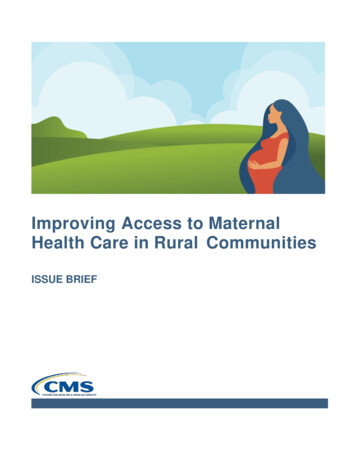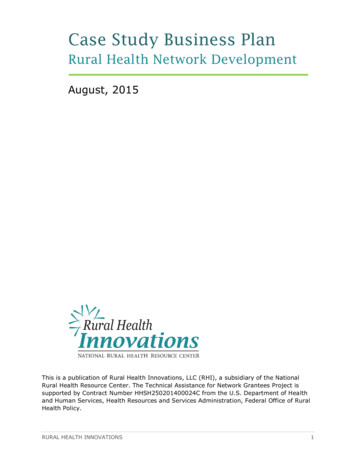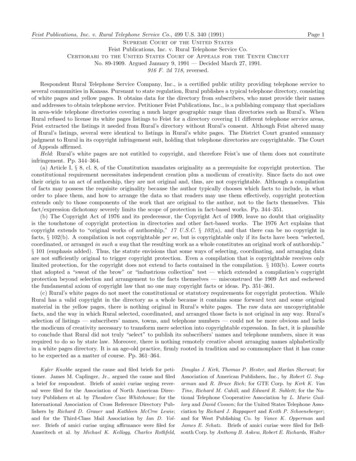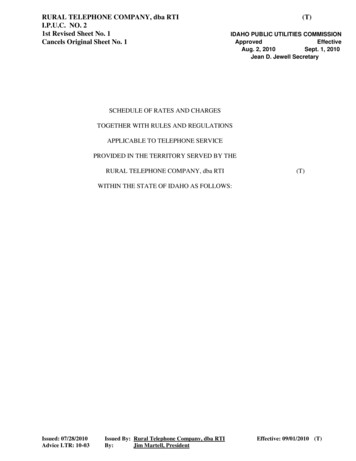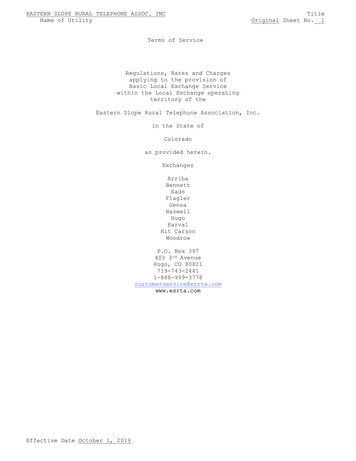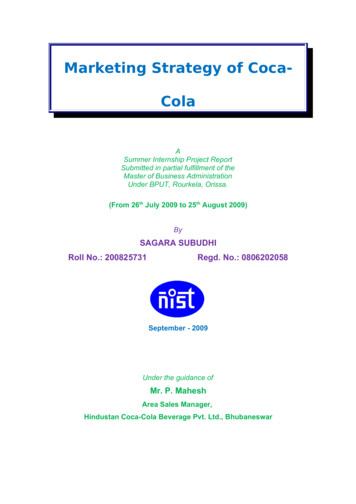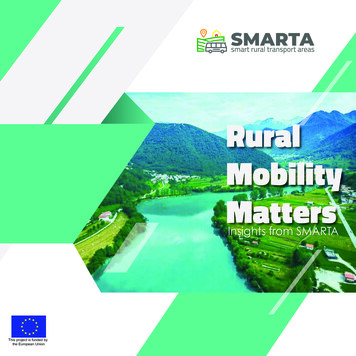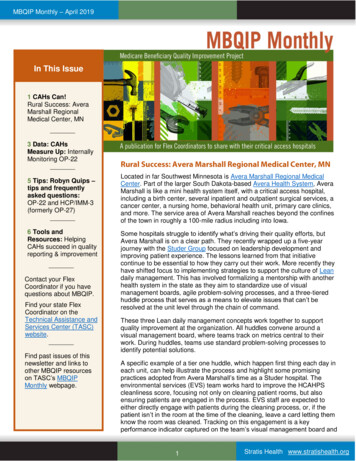
Transcription
MBQIP Monthly – April 2019’In This Issue1 CAHs Can!Rural Success: AveraMarshall RegionalMedical Center, MN3 Data: CAHsMeasure Up: InternallyMonitoring OP-225 Tips: Robyn Quips –tips and frequentlyasked questions:OP-22 and HCP/IMM-3(formerly OP-27)Located in far Southwest Minnesota is Avera Marshall Regional MedicalCenter. Part of the larger South Dakota-based Avera Health System, AveraMarshall is like a mini health system itself, with a critical access hospital,including a birth center, several inpatient and outpatient surgical services, acancer center, a nursing home, behavioral health unit, primary care clinics,and more. The service area of Avera Marshall reaches beyond the confinesof the town in roughly a 100-mile radius including into Iowa.6 Tools andResources: HelpingCAHs succeed in qualityreporting & improvementSome hospitals struggle to identify what’s driving their quality efforts, butAvera Marshall is on a clear path. They recently wrapped up a five-yearjourney with the Studer Group focused on leadership development andimproving patient experience. The lessons learned from that initiativecontinue to be essential to how they carry out their work. More recently theyhave shifted focus to implementing strategies to support the culture of Leandaily management. This has involved formalizing a mentorship with anotherhealth system in the state as they aim to standardize use of visualmanagement boards, agile problem-solving processes, and a three-tieredhuddle process that serves as a means to elevate issues that can’t beresolved at the unit level through the chain of command.Contact your FlexCoordinator if you havequestions about MBQIP.Find your state FlexCoordinator on theTechnical Assistance andServices Center (TASC)website.Find past issues of thisnewsletter and links toother MBQIP resourceson TASC’s MBQIPMonthly webpage.These three Lean daily management concepts work together to supportquality improvement at the organization. All huddles convene around avisual management board, where teams track on metrics central to theirwork. During huddles, teams use standard problem-solving processes toidentify potential solutions.A specific example of a tier one huddle, which happen first thing each day ineach unit, can help illustrate the process and highlight some promisingpractices adopted from Avera Marshall’s time as a Studer hospital. Theenvironmental services (EVS) team works hard to improve the HCAHPScleanliness score, focusing not only on cleaning patient rooms, but alsoensuring patients are engaged in the process. EVS staff are expected toeither directly engage with patients during the cleaning process, or, if thepatient isn’t in the room at the time of the cleaning, leave a card letting themknow the room was cleaned. Tracking on this engagement is a keyperformance indicator captured on the team’s visual management board and1Stratis Health www.stratishealth.org
MBQIP Monthly – April 2019linked to the overall goal of improving the HCAHPS cleanliness score. Dailyreview ensures accountability and allows the team to troubleshoot issues,elevating them to a tier two huddle if needed.Another focus area for HCAHPS found on visualmanagement boards is related to the dischargeprocess. Like many hospitals, Avera Marshall hasfound that despite being confident all patients receiveddischarge information, patients are not reflecting thatexperience when completing their HCAHPS survey.Furthermore, the organization is committed toimproving care transitions, reducing readmissions, andhas set a goal to complete discharges by 1:00 p.m.each day. To this end, discharge planning begins whena patient is admitted to the facility and patients areengaged in the process from the start. Follow-upappointments are scheduled before the day ofdischarge, and a team meets daily each morning to talkabout discharge planning, including the physician,Avera Marshall EVS team and their tier 1 huddle board.social worker, long-term care manager if appropriate,and the pharmacist, who can prioritize completing timely medicationreconciliation. Ensuring these items are addressed early not only helps tokeep things on schedule, but also allows ample time to talk to patients aboutwhat to expect next regarding follow-up, any changes to medication, and thedischarge plan, which is provided in writing in a folder clearly labeledDischarge Folder. All patients receive a follow-up call from the facility thenext day, offering an opportunity for further education, and ensuring theprocess is as seamless as possible.Beyond the core MBQIP measures, Avera Marshall is tracking on a myriadof other quality metrics, including those related to their busy birthing center,which delivered 570 babies in 2018, and multiple surgical services,including: orthopedics, ophthalmology, podiatry, and a newly launchedbariatric service. The birth center has successfullymaintained a zero elective early delivery rate afterimplementing a policy requiring the Chief NursingOfficer to review any requests for early delivery thatdon’t meet the exception criteria as laid out in thePC-01 measure. Also, Avera Marshall is an activeparticipant in the Hospital Improvement and InnovationNetwork (HIIN), in part focusing on reducing healthcareassociated infections, including surgical site infections.Avera Marshall Regional Medical Center.Avera Marshall is a high performer in another area ofinfection control with regards to influenzaimmunizations both among healthcare personnel, whoare oriented to the expectation upon hire and amonginpatients. They recently implemented a bi-directional flow of informationwith the state immunization record system and track closely on immunizationrates as a metric tied to their accountable care organization.A comprehensive and standardized approach to engaging all staff in qualitymeasurement and improvement enables Avera Marshall to achieve highperformance now and into the future.2Stratis Health www.stratishealth.org
MBQIP Monthly – April 2019In this month’s Robyn Quips, Robyn reminds us that submissions for themeasure OP-22 (percentage of patients who leave the emergencydepartment (ED) without being seen) are due soon! The encounter periodfor OP-22 is a full calendar year. In CAHs Measure Up, we’ll discuss someways you could track on this measure more frequently than just once a yearwhen you submit it. This way, your hospital can more quickly adjustpractices when it sees unexpected results in its data. RQITA’s InternalQuality Monitoring Tool (part of the Quality Improvement ImplementationGuide and Toolkit for Critical Access Hospitals) can help you do just that.This Excel-based tool is for internal use at your hospital. It does not replaceany reporting requirements. However, the tool can help you track progressand have all your data ready for state and national reporting. You mightconsider entering data into this tool monthly to track progress. And if it’s anoption, a good place to start is to enter past data to provide you a picture ofwhere hospital’s performance.Getting started with the Internal Quality Monitoring ToolHere are step-by-step instructions on how to start using the Internal Monitoring Tool for tracking OP-22monthly within your CAH. We’ve created the fictitious “Skyview Hospital” to illustrate.1. Download and save the tool to your computer network.2. Open the tool and review the instructions tab. Enter your hospital’s name in the yellow box:3. Click on the “OP-22 Percentage” tab at the bottom of your screen. You will need to scroll several tabsto the right to see it. The “Instructions” tab explains how to scroll.4. Complete the missing information in the yellow boxes under Background Information. The months andyears are automatically updated in the Monthly Measure Summary Trends for OP-22 table and thegraph to the right, based on the Frequency of Monitoring and Start Date of Monitoring that you enter.3Stratis Health www.stratishealth.org
MBQIP Monthly – April 20195. If it’s available, enter six months to one year of past data in the yellow boxes of the table MonthlyMeasure Summary Trends for OP-22. This will help you establish a past monthly baseline for OP-22at your hospital, which will be useful to compare against your real-time data going forward. Thepercentage column will calculate automatically.We’ve entered hypothetical data in the table below to illustrate, along with a potential goal (what theSkyview Hospital hopes to achieve) and some comments. The chart to the right of the table willautomatically be populated with data (blue line) and the goal (horizontal orange line) using what is enteredin the table.6. As each month passes, you can update the tool with that month’s data. Consider using the data tableor the graph as a conversation starter with key staff at your hospital. Based on what you see, youmight bring together a few people from the ED or your administration.a. If you notice a trend in the wrong direction or if it’s taking longer to achieve your goal than youplanned, talk about best practices or areas for improvement. Consider using other resourceswithin the Quality Improvement Implementation Guide and Toolkit for Critical Access Hospitals(including the Quality Improvement Measure Summaries) to help plan your next steps.b. If you see progress, celebrate the success!4Stratis Health www.stratishealth.org
MBQIP Monthly – April 2019Robyn Quips - tips and frequently asked questionsMeasures OP-22 and HCP/IMM-3 (formerly OP-27)May 15 is the once-yearly submission due date for measures OP-22:Left Without Being Seen and HCP/IMM-3 – Influenza VaccinationCoverage Among Healthcare Personnel. If you are new to thesemeasures, here are some resources to assist you in submitting them.OP-22 - Left Without Being SeenThis measure consists of the percent of patients who leave theEmergency Department without being evaluated by a physician,advanced practice nurse (APN) or physician assistant (PA). The May15th due date is for encounters in the previous calendar year, January2018 – December 2018. Because this measure uses administrative dataand is not chart-abstracted, CMS does not specify how to collect thedata. Instructions on what data needs to be collected and where tosubmit that data can be found starting on page six of the MBQIP QualityReporting Guide.HCP/IMM-3 - Influenza Vaccination Coverage AmongHealthcare PersonnelThe May 15 due date is for the flu season October 2018-March 2019.Data is submitted to the National Healthcare Safety Network (NHSN),and your facility must be enrolled in NHSN to report the measure. Ifyou’re confused about what happened to OP-27, refer to my column inthe March MBQIP Monthly. Training materials and FAQs on how tosubmit this data are available on the NHSN website and page 12 of theMBQIP Quality Reporting Guide.Go to GuidesHospital QualityMeasure Guides MBQIP QualityReporting GuideEmergencyDepartment TransferCommunicationsInpatient SpecificationsManualOpen Office Hours Call for Data AbstractorsThe next open office hours call for your MBQIP data abstractionquestions will be Wednesday, April 17, 2019.I usually don’t have an agenda, this is your opportunity to ask abstractionquestions, but this time I will start the call talking about the EmergencyDepartment Transfer Communication (EDTC) measure. In doing theAbstracting for Accuracy project and while answering abstractionquestions, it has come to my attention that many CAH’s are not pullingthe correct population for the measure. You aren’t at 100 percent on themeasure if you’re not abstracting all the cases that should be in thepopulation! Flex Coordinator’s, if your CAH’s are always at 100 percent,that’s great, but are they really? Maybe not if they’re pulling the incorrectpopulation.The call is free, but registration is required. The link to register is on theTools and Resources page of this issue.OutpatientSpecifications Manual5Stratis Health www.stratishealth.org
MBQIP Monthly – April 2019Ask Robyn – Quarterly Open Office Hours Calls for Data AbstractorsWednesday, April 17, 2019, 2:00 – 3:00 p.m. CT RegisterSometimes it just helps to talk to someone! Quality Reporting SpecialistRobyn Carlson will be offering open office hour calls to discuss your MBQIPabstraction questions. Sessions are free of charge, but registration isrequired. For more information about the Ask Robyn calls, contact RobynCarlson, rcarlson@stratishealth.org.Updated! MBQIP Quality Reporting GuideIntended to help Flex Coordinators, critical access hospital staff and othersinvolved with the Medicare Beneficiary Quality Improvement Project(MBQIP) understand the measure reporting process. For each reportingchannel, information is included on how to register for the site, whichmeasures are reported to the site and how to submit those measures tothe site.Antibiotic Stewardship Core Elements Report and CrosswalkInstructions for how to run a report of answers submitted in the survey asthey relate to implementation of the Core Elements of Antibiotic Stewardshipand a mapping of survey questions to Core Elements.National Healthcare Decisions Day (NHDD) is April 16NHDD can be an opportunity highlight the importance of advance careplanning as part of high quality care delivery. Resources listed below may behelpful to inspire, educate and empower the public and providers about thevalue of advance care planning. National Healthcare Decisions Day. Organizations can pledge toparticipate, identify other partners or organizations that are engagedand find tools, ideas, and suggestions to highlight advance careplanning in your community The Conversation Project. Tools and resources for individuals,families, and communities to help people talk about their wishes forend-of-life care. “Conversation Ready”: A Framework for Improving End-of-Life Care.A newly updated version this IHI white paper is now available to helphealth care organizations and clinicians provide respectful end-of-lifecare.MBQIP Monthly is produced by Stratis Health to highlight current information about theMedicare Beneficiary Quality Improvement Project (MBQIP). This newsletter is intended forFlex Coordinators to share with their critical access hospitals.This project is supported by the Health Resources and Services Administration (HRSA) of the U.S. Department of Healthand Human Services (HHS) as part of an award totaling 625,000 with 0% financed with non-governmental sources. Thecontents are those of the author(s) and do not necessarily represent the official view of, nor an endorsement, by HRSA,HHS or the U.S. Government. (11/2018)6Stratis Health www.stratishealth.org
management boards, agile problem-solving processes, and a three-tiered huddle process that serves as a means to elevate issues that can’t be resolved at the unit level through the chain of command. These three Lean daily management concepts work together to support quality impr




